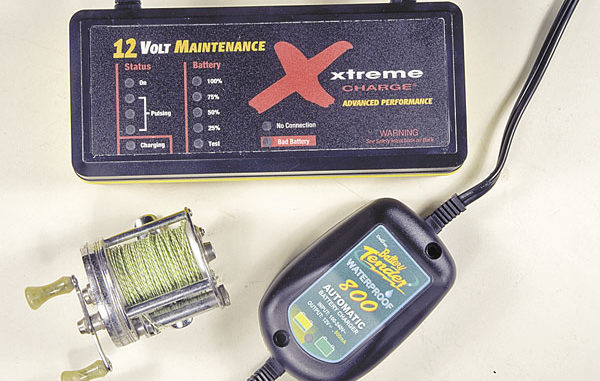
My truck pulls a travel trailer or a boat much of the year, but there are weeks when it just sits in the garage. Thinking it had been two weeks or so since I’d driven it, I figured I’d give it some exercise while running a few errands. When I opened the driver’s door, I noticed the interior lights didn’t come on, and I thought, “Uh-oh.” Sure enough, the battery was dead, and this was the second time I’d let it happen.
That’s a bigger deal than you may think. Batteries produce power as the sulfuric acid in their electrolyte combines with the lead in their plates, forming a spongy coating of lead sulfate on the plates as the battery discharges. When the battery is recharged, the coating breaks down, and the acid returns to the electrolyte.
If the coating is allowed to remain on the plates, it hardens into lead sulfate crystals over time. Tiny, scattered crystals form on the plates anyway, because even prompt recharging doesn’t remove all of the sulfate, but letting the battery sit in a discharged state helps them spread sort of like fertilizing the weeds in your lawn.
As the plates slowly “scab over” with these crystals, the area under them is insulated from the electrolyte, and the amount of electrical power the battery can make is reduced. Normal charging doesn’t break down the crystals, and the battery steadily loses power until it becomes useless — way before its components actually wear out.
Battery plate sulfation is a normal part of the discharge/recharge cycling of all lead-acid batteries, and there are two ways to minimize it. One is to promptly recharge the deep-cycle batteries in your boat or RV and keep them at least 75-percent charged while stored between uses. If you have a car, truck, 4-wheeler, personal watercraft, garden tractor or other piece of equipment with an electric starter, you can keep its starting battery fully charged with a small automatic charger.
The term “battery maintainer” has become standard for small, smart chargers that automatically put out just enough power to make up for the normal self-discharge that occurs in stored batteries and to counter the parasitic loads of engine computers, anti-theft alarms and other electronics common in modern mobile equipment.
These chargers sense battery condition and output no more power than the battery needs. They should not be confused with unregulated “trickle chargers” that can overcharge and ruin a battery over time. Deltran Battery Tenders and small chargers made by ChargeTek, Schumacher and other companies are relatively inexpensive and do a great job — just make sure you get models that are fully automatic.
Vowing to never let my truck’s battery go dead again and worrying a bit about damage I may already have done, I went to the local battery store and picked up a pulse charger made by PulseTech Products. This Southlake, Texas, company was the first I saw to use pulse technology in the recreational market. I’ve tracked the company for two decades as they made units for use on military, emergency service and commercial vehicles, and last year, I put a set of their units on my boat in hopes of extending battery life.
Pulse technology hits the battery with carefully structured bursts of power designed to break down plate sulfation that normal charging doesn’t touch, and it does it without damaging battery plates. Some units only pulse and others both pulse and charge.
I have also seen pulse units under other brand names including Rhino-Charge, VDC Electronics, DuraTrax and CTEK, and I’m sure there are more.
I’m hoping the PulseTech unit will clean up any problems my limited attention span may have caused and add years to my truck battery’s life. My suggestion for your batteries? Do as I say, don’t do as I do.


